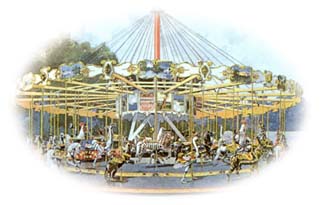The American Carousel – The Journal of Antiques and Collectibles – September 2001
By Marianne Stevens
Carousels have been around for several centuries, but not in the form that we now know them. They evolved from an ancient Arabian game, where mounted riders would try to catch balls filled with scented oil. Later, in 17th century Europe, horsemen riding at full speed tried to spear golden rings with their lances. To practice for this event, riders would mount crude wooden horses that were attached by beams to a central pole which was rotated by servants. Over time they have turned into a joyful ride to any place that one can imagine.
Around the turn of the last century, immigrants from Europe flooded our shores, looking for a better life, and they brought their skills with them.
Gustav Dentzel, whose family had been involved with carousels in Germany, is considered the pioneer carousel builder in America. He started as a cabinetmaker, but soon opened a shop in Philadelphia, specializing in the manufacture of carousels. Most of the immigrants had learned their skills making furniture or doing church sculptures.
One thing that strikes you immediately when viewing a vintage machine is that its figures are so much better than they had to be. These men took great pride in their work, and continually strove to make their carvings more ornate and beautiful than the competition.
Early carousel carvers followed basic patterns when making the figures commissioned for each merry-go-round. The animal’s hollow body construction sometimes contained up to 70 blocks of basswood. The side of the carousel facing the audience is known as the ‘romance’ side. This is where the carvers focused their greatest attention. Cherubs, eagles, flags, griffins, and other fanciful creations were added especially to the outside row animals.
The “golden age” of carousels was from 1875 to 1925, when there were ten firms, mainly based in Brooklyn and Philadelphia, trying to outdo each other by making their carousels bigger and better than the competition.
By the time World War I appeared on the scene, the market for carousels had almost reached capacity. The death knell for the industry was the depression of the 1920s. By 1925, most of the carvers had to seek other employment, and the carousel industry was almost gone. The last major carousel was put into operation in 1932, but this was composed of “stock on hand” the carvers had left years earlier. The men that remained got work mainly on repairing or redoing old machines, and hoping for better days.
In the 1970s, perhaps prompted by America’s Bicentennial, a wonderful thing began to happen. Items hand made in America began to gain a new appreciation. Hand carved carousels, cigar store Indians, quilts and the like got new respect.
Unfortunately, by that time many carousels were gone, the victims of neglect, abuse, and natures wrath. Of the five or six thousand made, there were very few left.
Antique carousels fall into three distinct categories. The “Philadelphia style,” which produced very beautiful, lifelike figures painted in earth tones. The factories that produced them were Dentzel, Daniel, Muller and Philadelphia Toboggan Company. “The Coney Island style” was made in Brooklyn and was gaudy, detailed, dramatic; straining at the bit to be free. The firms involved in this group were M.C. Illions, Stein & Goldstein, Charles Looff, and Charles Carmel.
The “Country Fair” style, carved mainly in upstate New York were simple, unadorned, portable figures, easy to transport, and move on to the next town. For many years these factories produced track machines, where the horses simply went round and round, not up and down. Portable machine producers were the Herschell Company, in its various forms, Charles Dare, and C.W. Parker of Leavenworth, Kansas. These small firms made hundreds of small, plain two row carousels. Herschell made over 88, as did C.W. Parker.
Sadly, there are only about 153 hand made vintage carousels left operating in the United States and Canada. Of that number, only about ninety are large, beautiful park-type carousels, meant for a permanent location, to be operated in a safe and secure building. There are probably another ten in storage, awaiting restoration.
Appreciation of the hand-carved carousel was a long time coming, but now something amazing is happening. There are now several companies who are making new carousels with hand carved wooden animals.
The Fort Wayne, Indiana zoo now has a new carousel right outside their Indonesian Rainforest exhibit. The carousel has tapirs, elephants, rhinos, and peacocks made, not of fiberglass, but of wood.
Its hard to assess the real drawing power of a beautifully made, beautifully maintained, vintage machine, but its definitely a large one. Parks like Disneyworld, Six Flags and Hershey Park have placed their old carousels in places of honor, to be enjoyed by all. Other cities like San Francisco and Lancaster, Pennsylvania have spent over a million dollars to get their old carousels back.
So we are fortunate that these immigrant carvers were so proud of their new country that they wanted to do their best. New England is fortunate to have so many beautiful antique machines. The citizens of Hull and Fall River were faced with losing their carousels, and formed organizations which raised the money to prevent losing them. So, enjoy all the wonderful old carousels that you can while they are still around. Two national organizations have been formed to prevent the loss of any more carousels. These are the American Carousel Society (401) 392-4289 and the National Carousel Association (812) 428-3675.
[amazon_carousel widget_type=”SearchAndAdd” width=”550″ height=”200″ title=”American Carousels” market_place=”US” shuffle_products=”False” show_border=”False” keywords=”American Carousels” browse_node=”” search_index=”Books” /]





Related posts: